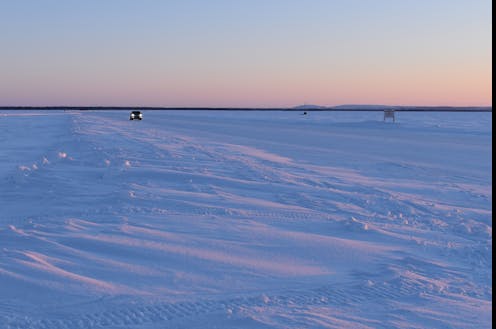
Walking on the ice of the Great Bear Lake in the N.W.T. is a truly unforgettable experience. It is simply one of Canada’s most breathtaking (and also largest) lakes. However, it is also facing challenges.
On my most recent trip to the lake, the sound of the ice cracking underfoot was pronounced. This sound was both unnerving and prompted reflection upon the future of this lake as a vital winter route.
In winter, the ice thickens to bear weights of up to 60,000 kilograms. At this thickness, the ice enables the transportation of essential supplies to isolated communities. The town of Délı̨nę, N.W.T., is especially dependent upon these icy highways.
Situated 544 kilometres northwest of Yellowknife, Délı̨nę lacks permanent road access. Instead, each winter, hundreds of transport trucks rely on the frozen lake to deliver critical supplies like food, fuel and household goods. This seasonal ice road is indispensable, serving as the community’s only reliable supply route during the northern winter.
Read more: Commercial whaling and climate change are inhibiting evolutionary change in Arctic whales
However, climate change has made these routes increasingly unpredictable, threatening public safety, infrastructure and the economy. Moreover, as extreme weather events become more frequent due to climate change, understanding their impact on ice roads is urgent.
While most academic research has focused on sea ice, the effects of climate change on lake ice are largely unexplored. Our research has sought to address this gap in our knowledge.
Fragile lifelines
Across Canada, about 10,000 kilometres of winter roads are constructed each year, many crossing ice-covered lakes. For northern communities, these ice roads are essential for economic stability, health and security.
While it’s evident that climate change affects the reliability of ice roads, the impact of extreme and variable weather on the formation and melting of lake ice remains poorly understood. Understanding these effects is crucial for the safe management of these vital routes.
In some regions, climate change has already disrupted transportation.
Low water levels on the Mackenzie River in the N.W.T. forced the cancellation of barge deliveries to local communities and resulted in a heavier reliance on ice roads in the winter.
Our research has shown clear evidence of climate-induced changes in lake ice thickness and range, break-up and freeze-up dates, as well as lake surface water temperatures across the North.
Working alongside various researchers, community members, local experts and decision-makers we are working towards developing a more comprehensive understanding of how lake ice forms and changes. Our goal is for this data to enable better decision-making and allow us to craft adaptation strategies that are both scientifically sound and culturally relevant.
This broad approach will not only improve the accuracy of predictions but also ensure that the proposed solutions are practical and grounded in local realities.
Capacity building
Capacity building within communities is crucial for the success of these initiatives.
Studying and monitoring Arctic and subarctic regions is costly. As such, there is a growing emphasis on efficiently co-ordinating governments and local partners to maximize the impact of research. Recognizing and incorporating the valuable contributions of Indigenous partners should be a priority for a more comprehensive research strategy.
Strengthening capacity within communities empowers local residents to ensure that research is conducted in a cost-efficient manner. At the same time, it also helps ensure that research is respectful of Indigenous knowledge, responsive to local needs and simulates local economies.
However, existing provincial, territorial and federal approaches struggle with adequately integrating the expertise, capacity and needs of the academic and local communities.
To address the challenges facing ice roads, a comprehensive action plan and research strategy is needed. This plan must emphasize collaboration across public and private sectors. This includes the development of smart monitoring systems, targeted training and clear communication between all stakeholders.
Enabling solutions
Building stronger partnerships among these groups is essential for crafting policies that are both effective and sustainable, ultimately leading to better-informed decisions that benefit both the environment and the communities that depend on it.
Achieving suitable outcomes necessitates active participation of researchers, Indigenous groups, government bodies, private industry and local communities. Evidence and knowledge-based decision-making must be the priority. All policies and strategies must be grounded in accurate data, local needs and practical realities to ensure they adequately respond to the unique challenges faced by northern regions.
Read more: The Canadian Arctic shows how understanding the effects of climate change requires long-term vision
These efforts are critical for communities like Délı̨nę, where a dependable winter road around Great Bear Lake is essential for survival.
As one walks on the magnificent ice of Great Bear Lake, hearing the sounds of cracking ice beneath can be unnerving. With each crack it becomes clearer just how fragile this vital natural highway is.
The ongoing changes in climate and transportation infrastructure underline the importance of developing sustainable, adaptable solutions that can meet the needs of remote northern communities in the face of uncertainty.
The authors do not work for, consult, own shares in or receive funding from any company or organisation that would benefit from this article, and have disclosed no relevant affiliations beyond their academic appointment.
This article was originally published on The Conversation. Read the original article.







